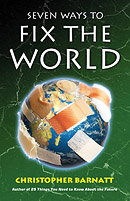 |
|
|
|
You are in: Future Challenges : Food Shortages
Food Shortages
According to the United Nations World Food Programme, today 795 million people are undernourished and hence unable to lead a heathy, active lifestyle. That's one human being in nine, with about 3.1 million children each year (or about 350 every hour) dying of malnutrition. To cite another shocking statistic, 1 in 6 children in developing countries (or about 100 million) are underweight. As these figures illustrate, humanity has not learnt to feed itself today. And this really does not bode well for the future.
In the face of the "perfect storm" of climate change, Peak Oil and Peak Water -- not to mention rising population levels and rising industrialization -- food supply and food security look destined to become increasingly problematic. For a start, as oil supplies dwindle and in the longer-term become more expensive, the use of oil-based pesticides and oil-powered food transportation and farm machinery will become less and less feasible. You can find quite an alarming article on how reliant our food supply is on oil here. Peak Water is also already leading to reduce yields of corn, rice and other staple foods around the globe. Rising climate change is also having a similar effect. And the fact that the world's population continues to increase by about 79 million people a year will hardly help up keep every human being fed, not least when around a billion people every day already go to bed hungry. Increasing Meat ConsumptionIn addition to Peak Oil, Peak Water, climate change and rising population levels, four other factors are going to place increasing pressures on our available food supply. Firstly, with rising industrialization the proportion of meat in the average diet is increasing. This is problematic given that diets that are rich in meat are more resource intensive. This is simply because all animals bred for table have to be sustained from birth to the slaughterhoure. When we eat meat we are therefore indirectly consuming the quantity of food that our chosen animal has been fed in its lifetime. To put this in context, the most meat intensive diets in the world are consumed in the United States and Canada. This means that in these nations every person requires about 800kg of grain to be harvested each year -- most of which is fed to animals. In contrast, in India the average person requires only about 200kg of grain per year, almost all of which is directly consumed as part of a largely meat-free diet. Fairly obviously, as people in China, India and other industrializing nations demand more meat, pressure on agricultural resources is going to become more and more intense. To put this in context, while China's population has increased by about 10 per cent in the last decade, its demand for meat has increased bymore like 400 per cent. There simply is not enough land on the planet for everybody to eat the quantity of mean that most people in the Western world are currently lucky enough to consume on a regular basis. Declining Fish Stocks SuppliesAnother downward pressure on future food supplies is declining fish stocks. Alarmingly, three quarters of fish stocks are already being fished at of beyond capacity, or are now having to be rested as a result of previous over-fishing. Like it or not, in the future fish will soon be in shorter and shorter supply regardless of where we happen to live. In fact, according to the ten year Census of Marine Life reported in 2010, unless action if taken it is likely that commercial fishing on a global scale will collapse entirely by about 2050. And you will sadly not be surprised to learn that, while fish stocks are starting to be managed more sustainably in some waters, in general radical action has yet to be taken. The Folly of Non-Food AgricultureAnother major issue is non-food agriculture. Unfortunately many people have convinced themselves that the way to deal with Peak Oil and/or climate change is to fill their vehicle's tanks with a petroleum substitute manufactured from crops grown on land that once produced food -- or that was very recently a happily-growing tropical rain forest. In the future synthetic biology may allow third-generation biofuels and indeed bioplastics to be manufactured using algae or from agricultural waste. However, until that time, a misguided demand for biofuels is likely to result in millions of people going hungry. The Pressure on LandFinally, due to all of the above, viable agricultural land is becoming a scarcer and more premium resource. For many years now, rich countries have been buying-up land in poor countries to protect their own future food supplies. Worse still, the sad fact for everybody is that the productivity of around 30 per cent of the world's agricultural land is already decreasing. This is due to over-grazing, over-ploughing and deforestation, in turn resulting in soil erosion (which in also being driven by Peak Water and climate change). In short, we are currently over-exploiting land just as we are over-exploiting all other natural resources. Solutions like vertical farms that allow us to create new "stacked" vertical fields may therefore soon be needed in spades. Time for a RevolutionThe time has now come for most of us to review what we eat, where it has come from, and how it is farmed. Already Europe imports most of its fish and a lot of its fruit and vegetables from countries that cannot feed themselves. Parched regions of the planet also regularly now sell "water" to relatively saturated nations via their food exports, with every imported lettuce or runner bean transporting a little water from a thirsty continent to one that has far more water. Almost certainly, whilst Peak Oil may change our way of life and Peak Water may alter further how we live, it is pending global food shortages that are likely to spur the greatest human suffering in the 2020s and 2030s. Current Western dietary habits are simply not sustainable anymore -- let alone in the future, let alone for the whole industrializing planet. Indeed meat-rich, oil-hungry ways of eating are only still being made possible for a few fortunate billions because so many of our fellow human beings are being allowed to starve on far more sustainable diets. The West has drained its own fish stocks, given up on seasonality, and is now raping the lands and natural resources of the poor to keep the richness and variety of food that it desires and "needs" in its TV dinners. But things will change. And pretty fast for us all. For better or for worse, we now stand on the brink of a major Food Revolution More information on future food shortages can be found in my book 25 Things You Need to Know About the Future. Meanwhile its sequel, Seven Ways to Fix the World discusses a range of possible solutions to those many future challenges that we face. Finally, you may also find interesting my interview on the future of food in Epicurious. Return to Future Challenges. |
 Even today, 795 million people do not have enough to eat, while 350 children die of malnutrition every hour. And without dramatic action, in the decades ahead these figures are very likely to increase.  Learn about Food Shortage solutions |
|
|